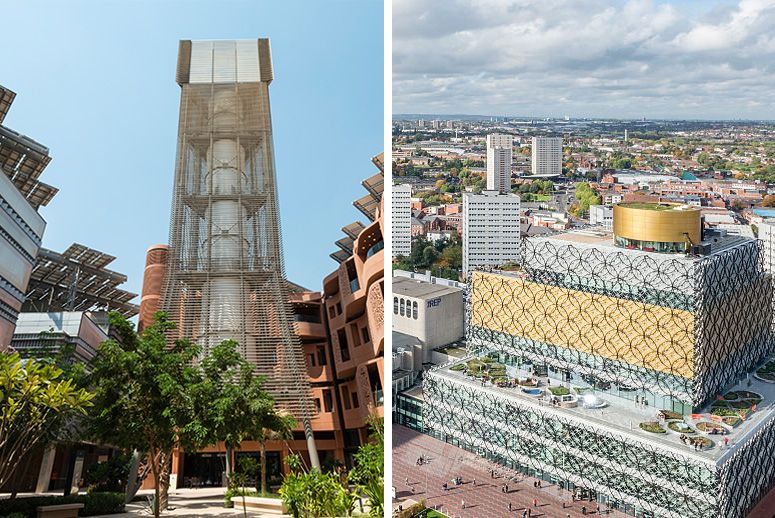LESSONS FROM A CITY BUILT WITHOUT LIGHT SWITCHES AND WATER TAPS
The best way to future-proof cities is to let them innovate—and sometimes fail.
Wind tower at Masdar Institute of Science and Technology in Masdar City, United Arab Emirates (left); Birmingham, England. (Photos: Iain Masterton/Getty Images; Loop Images/UIG via Getty Images)
Sep 19, 2016
Katharine Gammon has written for Nature, Wired, Discover, and Popular Science. A new mom, she lives in Santa Monica.
For 2,000 residents living just outside Abu Dhabi, United Arab Emirates, experiencing the city of the future is a kind of waking dream. Masdar City is designed to take advantage of renewable energy, with a goal of being the most sustainable city in the world.
It doesn’t even have light switches or water taps.
The 87,000 solar panels that power the city and the mostly recycled water running through its pipes respond to human movement. If you’re not around to use them, the lights aren’t on and the water isn’t flowing—an innovation that cuts electricity and water consumption by 51 and 55 percent, respectively.
It’s a progressive implementation, but that doesn’t mean the city is totally future-proof, says a new report published in Renewable and Sustainable Energy Review.
“Cities have to be able to innovate, experiment, and adapt to changing conditions,” said Peter Braithwaite, a civil engineer at the University of Birmingham in the U.K., who coauthored the study.
The researchers compared energy use in fresh-faced Masdar with energy use in Birmingham—a 400-year-old city with an industrial history. They analyzed both cities as living ecosystems and found startling similarities.
Both cities are dependent on oil but in different ways, and both have strategies for reducing emissions and reliance on carbon fuels, said Braithwaite.
In terms of planning for the future, even a brand-new city like Masdar can struggle, the study found.
“We knew that Birmingham with its long industrial history was locked into infrastructure, but what we discovered was Masdar could be in danger of getting locked into certain renewable systems,” Braithwaite said.
An Old Source of Renewable Energy Gets a New Look
Masdar relies mostly on concentrated solar power that is supplemented by natural gas, while Birmingham still relies heavily on carbon-based fuels. In its original design, Masdar aimed to be zero-carbon, but now city officials have replaced that goal with being the world’s “most sustainable” city. Currently, 75 percent of the total water heating in the city is produced by solar energy, and Masdar is exporting its surplus solar energy to help reduce neighboring Abu Dhabi’s reliance on oil and gas.
In Birmingham, the city remains dependent on fossil fuels, with renewable power only contributing 15 percent of electricity generation. Still, Birmingham has made strides in other areas, using sewage to create methane—which can be used as a fuel source—and improving energy efficiency through better insulation.
Both cities are striving for sustainability, but Birmingham is locked into infrastructure such as cars that require fossil fuels. Infrastructure is slow and expensive to change, so avoiding getting set into specific systems is a better plan. For Masdar, the researchers suggest that the city shouldn’t rely wholly on solar for renewable power. One opportunity could be developing energy from waste, something Birmingham has done efficiently, Braithwaite said.
Developers have scaled back the ambitious scope of the original plans for Masdar. When the city was conceived in 2006, it was envisioned to cover 2.3 square miles. After the global recession in 2008, its boundaries were reined in and its completion date pushed back. So far, only 5 percent of the area has been developed, and the new plan is for the city to be completed by 2030, with a population of 40,000.
While there have been setbacks, the city’s core is completed; it has innovative features such as a Teflon-coated wind tower that helps push cooling breezes down the surrounding streets. Street-level solar canopies provide shade, and a massive wall keeps desert dust, winds, and noise out of the city.
To succeed, Braithwaite said future cities will need to be able to fail—an idea that tends to make politicians run for cover.
He pointed to the developing world as a place where countries are choosing systems that allow flexibility in setting up infrastructure. A good historical example is phones: In the developed world, landlines dominated for years past their prime, but in the developing world, mobile technology swiftly took over. Nimble cities can lead to more flexible and adaptable cities.
“Cities need the ability to innovate, look at new systems, and do experimentation,” said Braithwaite. “If you are trying to innovate, you can’t assume that every new innovation will be successful.”







Follow Us!